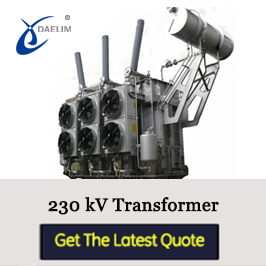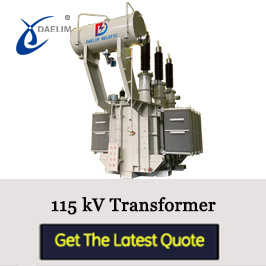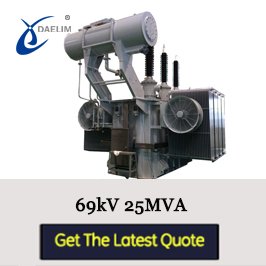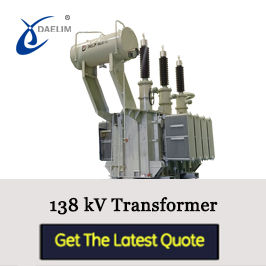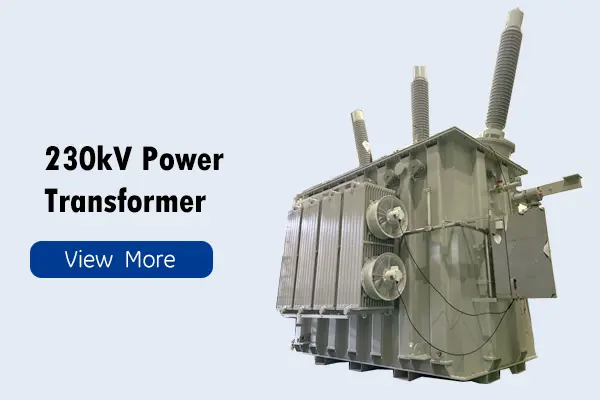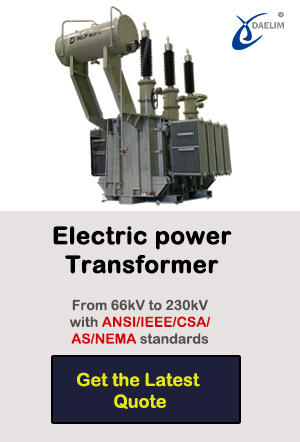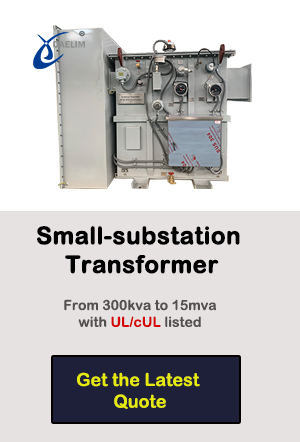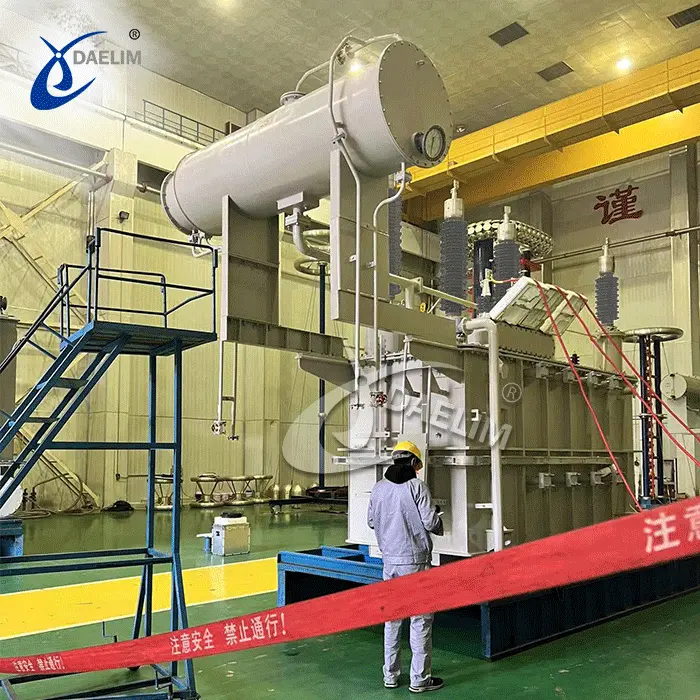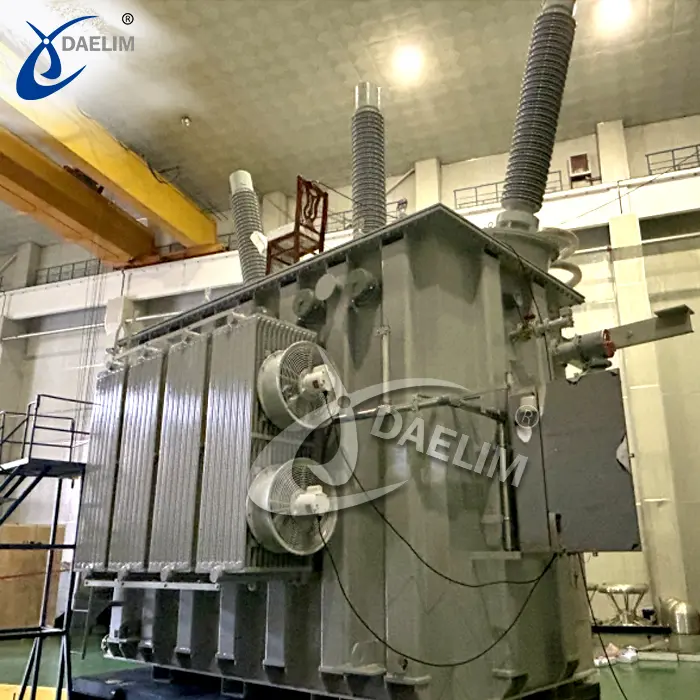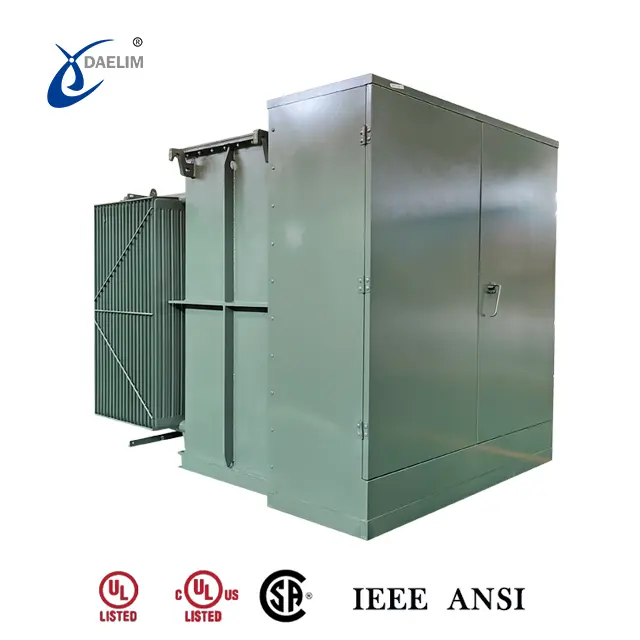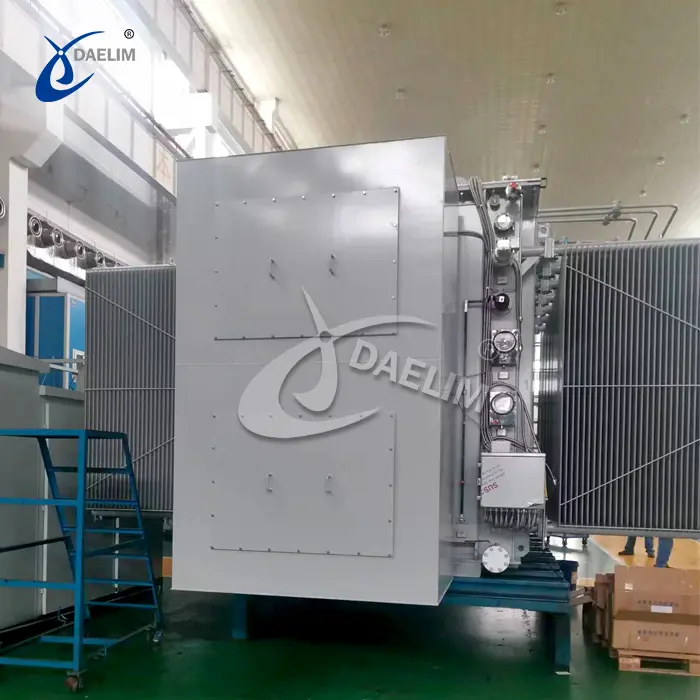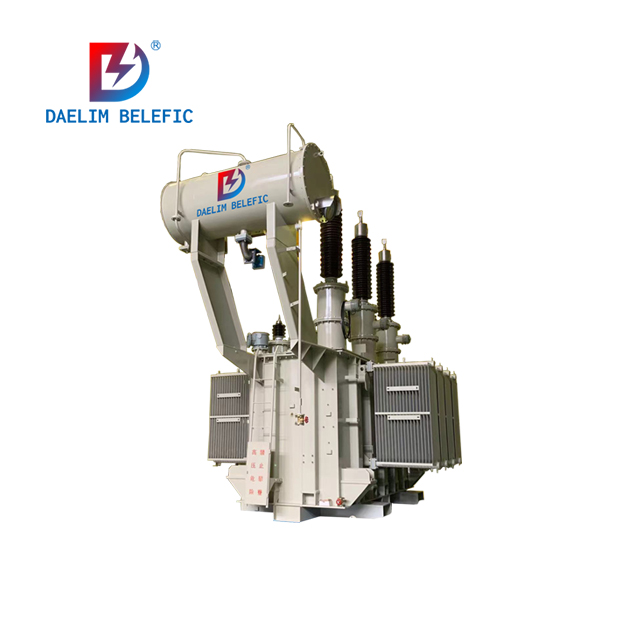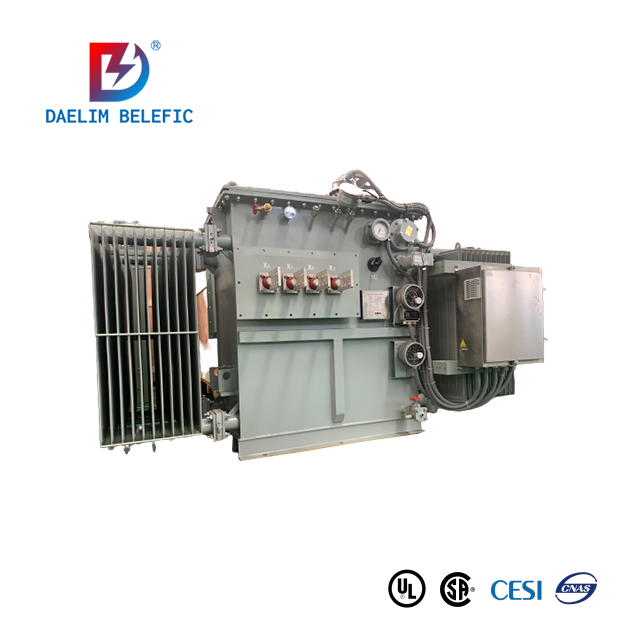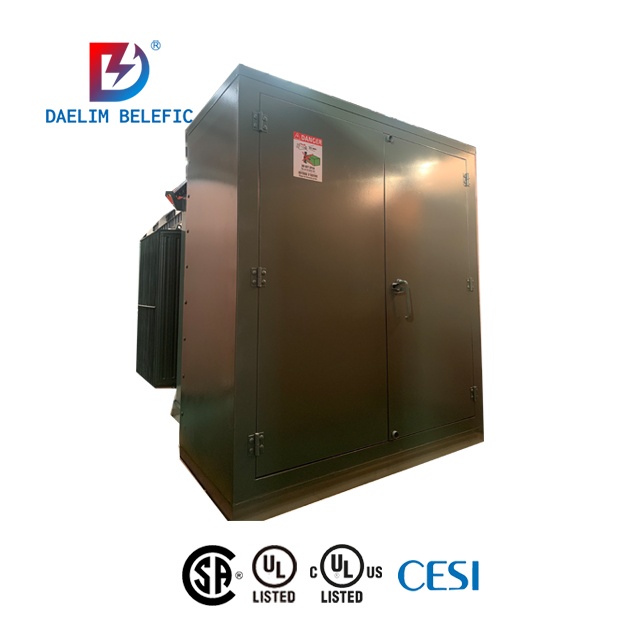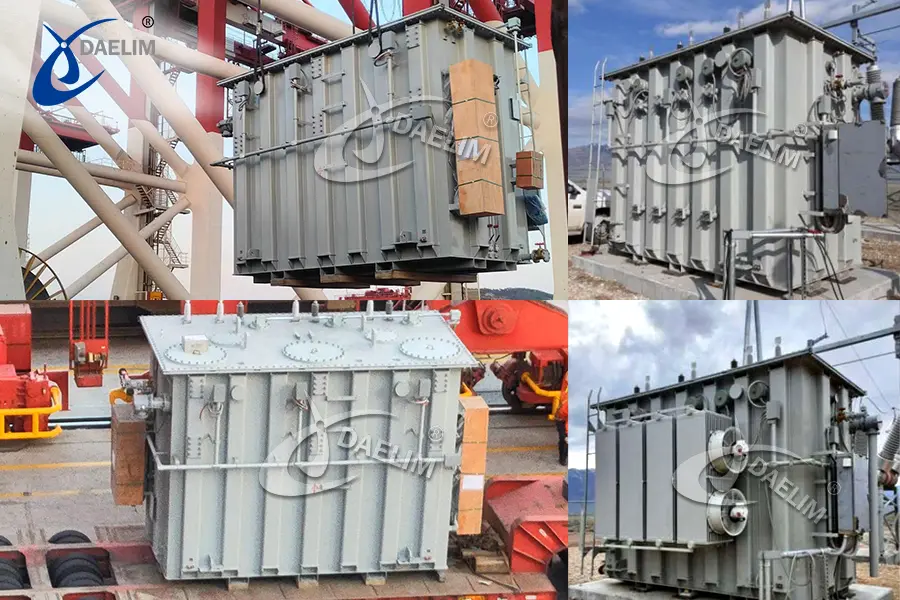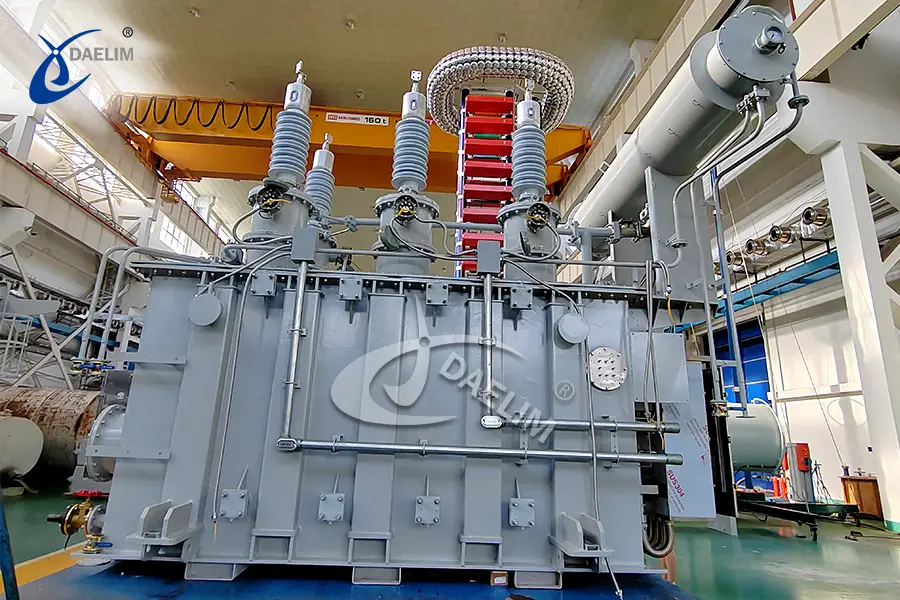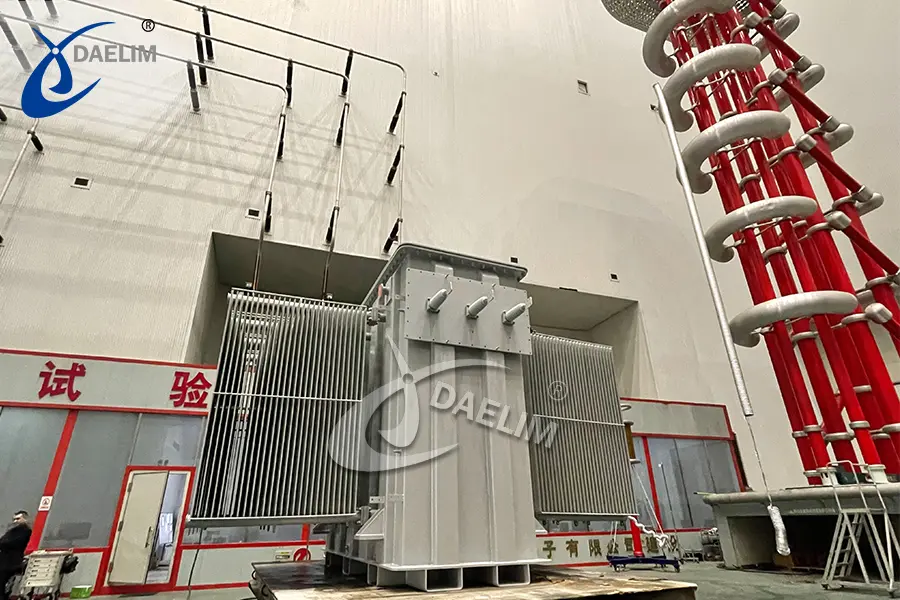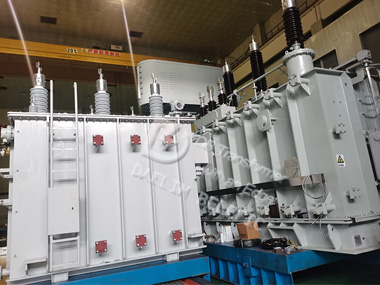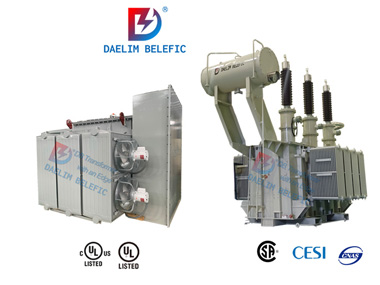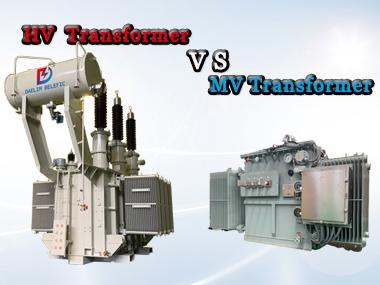Transmission Transformer | At The Power Lines Core
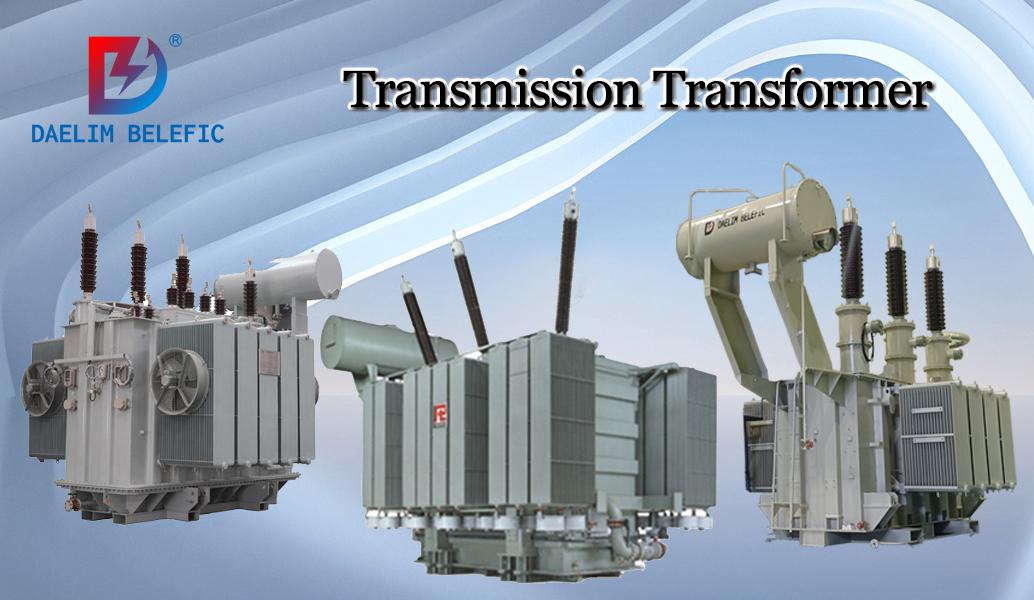
When it comes to power, there is no such thing as one size fits all. Thankfully, transformers like transmission transformers exist. They are the ones responsible for making power sizable and usable.
Sure you have heard about transmission transformers but do you really know what it is? In this article, we will dive deeper into what transmission transformers are, their variations, their purpose, connections, and how they make our lives easier.
We will also showcase some of Daelim’s range of transmission transformers and their specifications.
What is a transmission transformer?
Transmission transformers also known as power transformers are primarily used for power transmission and can also be used as a power receivers.
Like other transformers, transmission transformers are not designed to have moving parts and basically deal with electrical systems with alternating currents.
They usually operate at very high voltages measured in mega Volt-Ampere and ratings can range from 200 mega Volt-Ampere or higher.
Operating at high voltage increases efficiency and minimizes power losses while transmitting huge amounts of power across long distances.
The transmission transformer may have an 11kV up to 756 kV voltage ratio and is expected to work at full load while running at maximum efficiency.
Read more: High Voltage vs Medium Voltage Transformer
They are mainly used for stepping up power produced to facilitate the transmission of power from the source to the distribution hub before the actual power distribution.
Since transmission transformers handle high voltages they usually come in massive sizes and are designed as an oil-immersed type that could last for more than 30 years provided that is properly maintained.
Types of Transmission Transformers
Transmission transformer types are classified according to their range. The range is divided into three, these are large transmission transformers, medium transmission transformers, and small transmission transformers.
Try for free: The Ultimate FAQs Guide To Types of Substation
Large Transmission Transformers
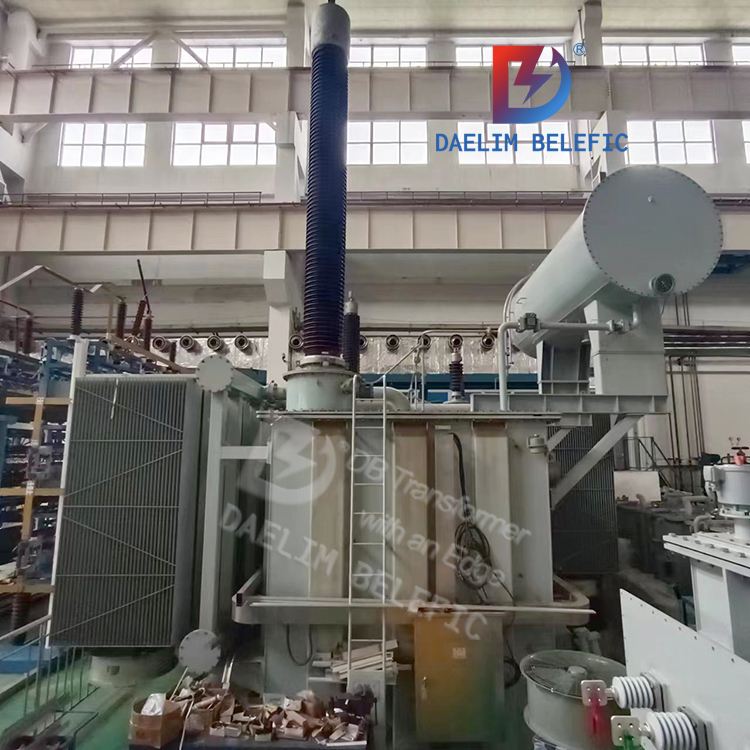
This range starts from 100 MVA and above. It is expected to hold out very high loads of current. Most of Daelim’s 100MVA power transformers are made with a toroidal core.
Toroidal transformers are more advantageous in many ways than traditional transformer types. It is lightweight, does not emit heat, and requires less maintenance.
Moreover, no matter how large your requirement is you can always count on Daelim to work with your design and make it possible.
Medium Transmission Transformers
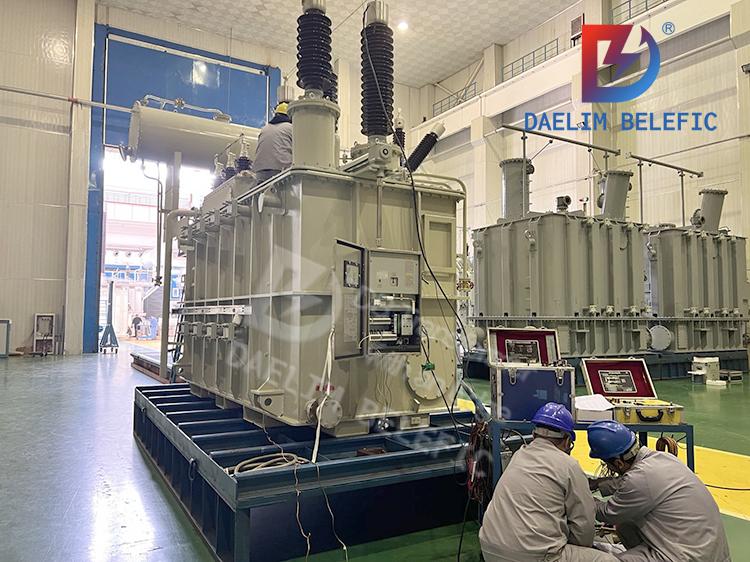
The range starts from anywhere above 7500 kVA up to not more than 100 MVA. This range can transfer both high and low-voltage loads. They are very versatile and cost-effective.
This range is where mostly customization starts as most small transmission transformers are made in standard sizes. But, Daelim also has standard medium size transformers.
Small Transmission Transformers
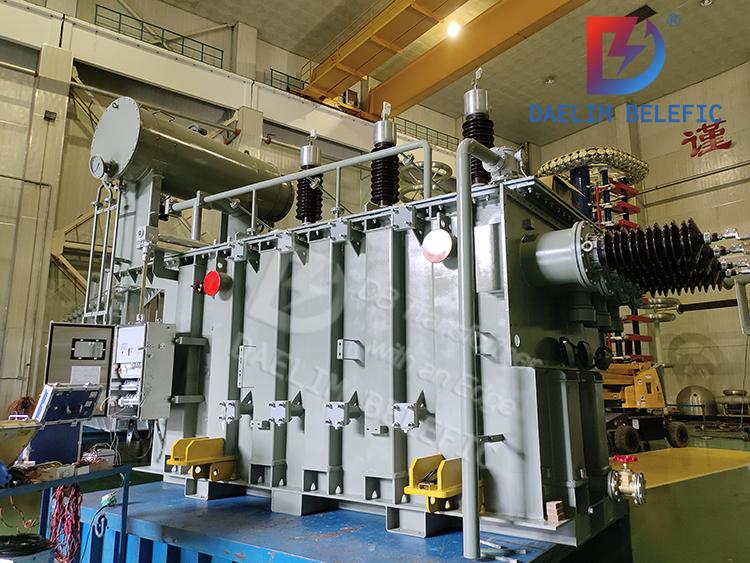
This range includes power transformers that have 500 kVA up to 7500 kVA. It is the most common power transmission you can find.
These types can be pad-mounted or pole-mounted and are also used in the downstream or distribution systems.
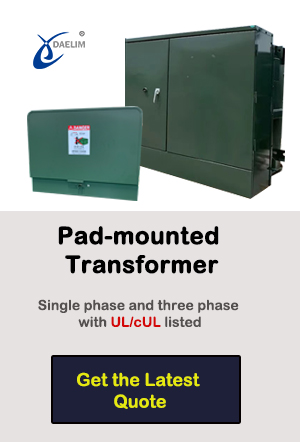
Pad mounted power transformers are safely used within crowded areas as it is enclosed. They can also be used for sub-box combinations.
Learn more about pad mount transformer: 3 Phase Pad Mounted Transformer
Pole mounted power transformers are the ones used on electric poles on the industrial and community level. Daelim small transmission transformers are reliable and are tested to last for more than 20 years.
Daelim can cater to a wide range of transmission transformer needs. Let us know your requirements and we will be glad to present to you our cluster of high-end transmission transformers.
Whatever size your requirement is, you will definitely find it at Daelim. We do not only serve standard sizes but since we have our own manufacturing site, we can also offer customization.
What is the purpose of a transmission transformer?
Basically, transmission transformers make power transmission possible. It controls the voltage level before it is transmitted and along the line.
You may enjoy: Why Substation Transformers Are So Important In Power System?
Transmission transformers are also a key component that increases power transmission efficiency as it is the instrument used to step up the load before it is transferred to another station, this is done to minimize power losses.
In summary, transmission transformer:
- Aids general power transmission over long distances.
- Secure safety along high-powered transmission lines.
- Step up the power load.
- Reduce line losses.
- Supply power to other stations.
- To transfer power at any point in case of power emergencies.
Get it now: What Transformers Are Using In Power Plants?
Why is a transformer necessary for the transmission of electricity?
Transmission transformers are technically required to produce safe and usable electricity which is one of our basic necessities.
Safe, since these transformers under normal conditions are designed to carry heavy electrical loads without getting burned.
Usable, these large amounts of power from the power generating stations are not yet safe for use. It will have to pass through a transformer or several transformers before this power is delivered to distribution systems.
There are different transformers along the power line, mainly for stepping-up and stepping-down purposes. From the distribution system, another transformer is used to transform power according to the customer's needs.
Which transformer is used for transmission?
Power transformers, these transformers belong to a large spectrum of rated capacities and are sized according to the transmission line's requirement.
Transmission transformers are largely sized, making them powerful enough to transmit high voltages from the source and to the distribution systems.
It can either be a step up transformer or a step down transformer. Step up transformers are used at the power generating end, while the step down transformer is positioned at substations or within the distribution lines. Daelim can serve both step up and step down transformers.
Daelim transmission transformers are not only used within the power lines but these transformers are also used to cater to various platforms around the world such as solar power generation, large mobile substations, and a lot more.
Read more: Different Transformer Types and Their Applications
Daelim’s Power Transformer Range
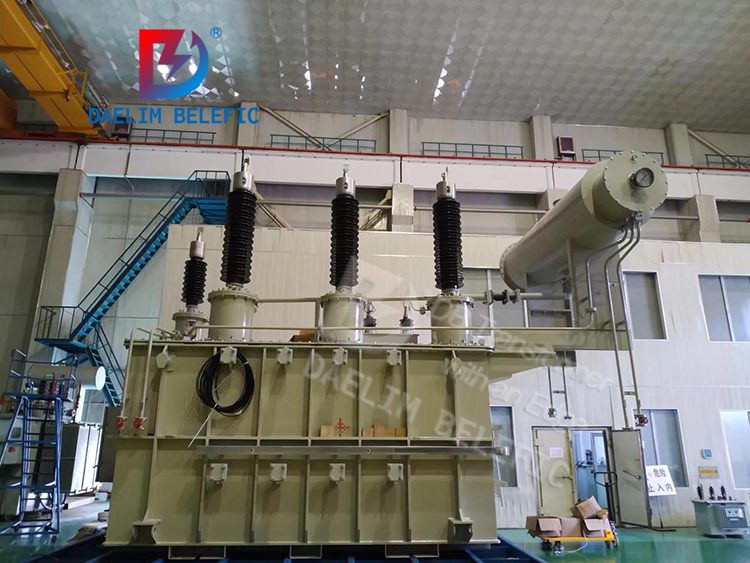
Capacity: up to 500 MVA
Primary Voltage: up to 345 kV
Frequency: 50/60Hz
Insulation Fluids: Mineral Oil Inhibited | Not inhibited | Vegetable Oil
Standards: UL/cUL, CSA, IEEE, and CESI certified. Well-designed and manufactured to achieve the highest quality in accordance with international standards for transformers such as ANSI/IEEE, CSA, AS/AZS, DOE, NEMA, IEC, GOST, and or as per customer’s request.
Why transformer is used in long-distance transmission?
Power is typically produced in power plants that are distantly located; that power has to be transmitted over a long distance before it reaches the distribution systems or the service area.
The problem with that is that as the distance increases the resistance as it is accumulated over the power lines.
As the resistance increases, the greater the barrier or obstruction is created that prevents current from flowing freely.
When that happens, power is lost and is wasted within the lines in the form of heat. This is where the transmission line transformer came in.
To minimize power losses, a transmission transformer is needed to step up the voltage before it travels down to the power lines.
As the voltage is increased, the current is reduced, and there is less resistance which leads to minimal power losses.
Once power is successfully transmitted to the substation, another transformer is needed to step down the voltage to a usable level before it is delivered to homes and businesses.
Try for free: High Voltage Transformer Guide
Which type of connection is used in a transmission transformer?
Because of the high voltage requirement, three-phase connection is the commonly used transmission transformer connection.
This connection can either be done with a single three phase transformer or by connecting three single phase transformers.
However, it is more practical to use a single three phase transformer as you can largely save space, cost, and overall it also weighs lighter.
Using a single three phase transformer can also minimize the power losses as compared to using three single phase transformers.
When it comes to three phase transmission transformers, there are two basic winding connections. The delta connection and the wye connection or also known as the star connection.
Keep reading: The Ultimate FAQs Guide To Transformer Connection
A three phase transformer has three different coils, and each coil is wired into respective phases. These phases must have a common linkage to enable the flow of power across its coils.
A delta connection resembles a triangular coil connection where each side represents the individual phases.
On the other hand, a wye connection resembles a three-axis connection where each phase is joined at one end while the other end is open-ended.
These two connections may be very different in many ways. They both work differently upon power application. Each also has its own set of advantages and disadvantages.
However, you can make the most of these two in combination. You can have a delta connection for both your primary and secondary or both star connections.
But you can also have the following combination:
- Delta on the primary, star on the secondary
- Star on the primary, delta on the secondary
- Interconnected star on the primary, delta on the secondary
- Interconnected star on the primary, star on the secondary
If you are not confident about which combination is best for your system, you can always consult our experts. We can assist and help you safely plan your connection before you have the actual installation.
Transmission Transformer Manufacturer
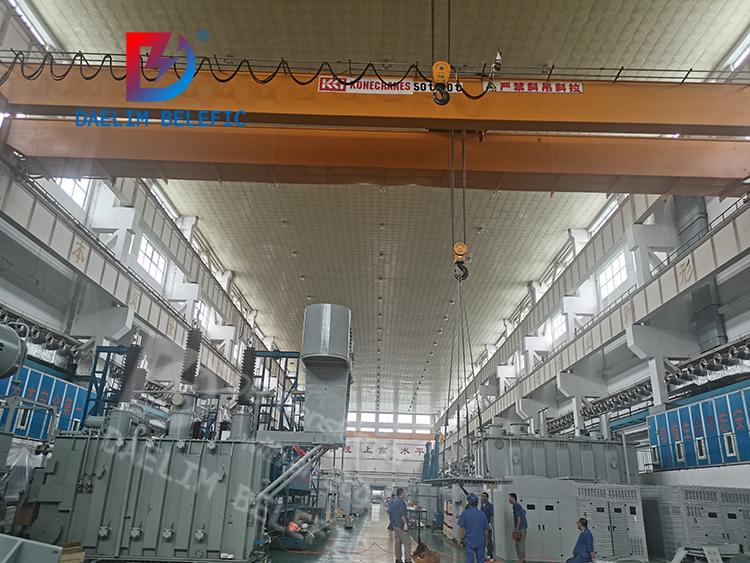
There are many transmission transformer manufacturers around but it is either too expensive or cheap but of low quality. With Daelim, you will find a balance between quality and price.
Having our own manufacturing plant, Daelim can offer you a more competitive price over the others. When it comes to quality, that is not a question. Transmission transformers are one of Daelim's expertise.
Reading on: Power Transformer Manufacturers Around the World
With over 300 million sales distributed around the world and over 15 years of manufacturing experience, Daelim has made its mark in the field of manufacturing no less than high-quality transformers.
In spite of that, Daelim is still continuously striving to innovate to be able to serve every customer's needs with a wide variety of transformers ranging from small transmission transformers to massive mega-size transformers.
As Daelim continues to expand, we bring our service closer. We have extended our local after-sales teams around North, South, and Central America so it's easier for you to reach us in case you need any assistance in the operation, maintenance, upgrading, or if you have any inquiries.
Here are some of the Daelim Transmission Transformers. If you do not find your requirement in this range, kindly get in touch. We would be glad to discuss and customize with you.
230 kV Class Three Phase Two Winding OLTC Power Transformer
| Rated Power (kVA) | High Voltage (kV) | Low Voltage (kV) | Short Circuit Impedance | No - load Loss (KW) | On - load Loss (KW) | No load Current (%) |
| 30 000 | 230 | 6.3 6.6 10.5 11 34.5 66 | 12% | 30 | 128 | 0.69 |
| 37 500 | 36 | 149 | 0.63 | |||
| 50 000 | 43 | 180 | 0.63 | |||
| 60 000 | 50 | 209 | 0.57 |
230 kV Class Three Phase Two Winding NLTC Power Transformer
| Rated Power (kVA) | High Voltage (kV) | Low Voltage (kV) | Short Circuit Impedance | No - load Loss (KW) | On - load Loss (KW) | No load Current (%) |
| 30 000 | 230 | 6.3 6.6 10.5 11 34.5 66 | 12% | 28 | 128 | 0.7 |
| 37 500 | 33 | 149 | 0.7 | |||
| 50 000 | 39 | 180 | 0.65 | |||
| 60 000 | 46 | 209 | 0.65 |
230 kV Three Phase Power Transformer For USA Market
Conclusion
The transmission line transformer serves as the core of the power lines. Without these instruments, we would not enjoy safe and reliable electricity today.
This makes Daelim more empowered to develop and manufacture high-quality transformers to serve your energy need.
If ever you are having trouble with your existing transmission transformer, Daelim can also help you with the rehabilitation and upgrading requirements.
Or in case you are experiencing any trouble with your existing suppliers like slow service, delayed delivery, or poor customer service maybe it's time to shift.
Feel free to Contact Daelim Transfroemr anytime. Give us a call or chat with us, our customer service is open to serving you anytime.
Related Products
Related Article
230 kV Three Phase Power Transformer For USA Market
In 2023, Daelim Transformer designed and manufactured a cutting-edge 230 kV three-phase power transformer for a client in Nevada, USA. The client recently shared installation and operational photos, showcasing the successful deployment of this remarkable transformer. Let's delve into the specifics of this transformer project!
Canadian 69 kV Substation Transformer Project
Today, we are excited to present a case study on a 69 kV substation transformer project by Daelim Transformer. Our Canadian client required a step-down transformer for their substation to connect with the hydroelectric grid in Quebec.
20MVA Power Transformer for the United States
This project involves the development of a 20 MVA three-phase power transformer tailored for the United States market. The primary voltage is 24.94kV, and the secondary voltage is 4.16kV, indicating it functions as a step-down transformer. The design and production fully comply with IEEE C57.12.00 standards and have passed third-party UL team testing. All accessories also adhere to IEEE standards. FR3 vegetable oil serves as the insulating liquid for the transformers.
The Ultimate FAQs Guide To GSU Transformer
Are you looking to purchase a generator step-up transformer (GSU) for your business? Are you responsible for their operation? If so, then you should know that there's quite a lot to know about them. But while GSUs are critical pieces of equipment, they're also quite complex. So to help you understand them better, we've compiled a list of answers to some of the most frequently asked questions about GSUs.
The Ultimate FAQs Guid To Oil Type Transformer
An oil-type transformer is a kind of transformer that uses oil as a cooling and insulating medium. The core and coils of an oil-type transformer are immersed in oil, which helps to cool the transformer and provides insulation.
High Voltage vs Medium Voltage Transformer
Daelim is a transformer manufacturer specializing in producing Medium Voltage and High Voltage Transformers. Has a series of certificates: UL/CUL, CSA, CESI, CE, SGS, IEEE, etc. Transformer technical standards exceed ANSI/IEEE, CSA, AS/AZS, GOST, IEC, etc. It has the advantage of fast delivery.

